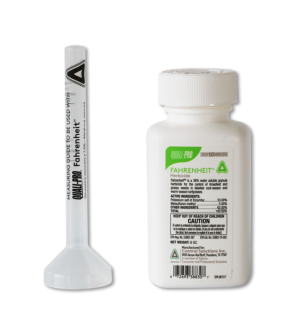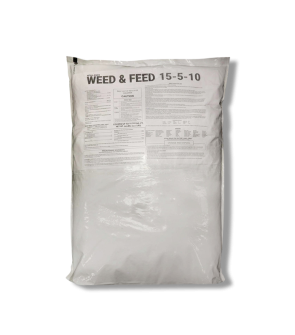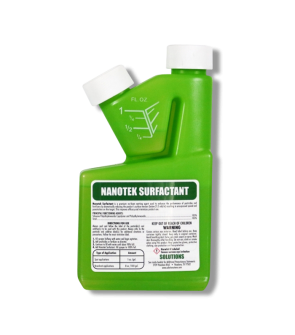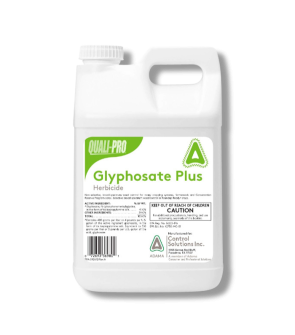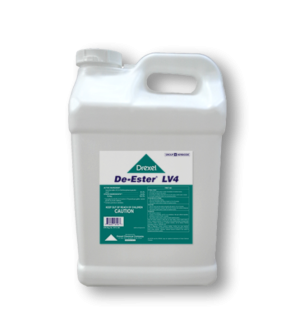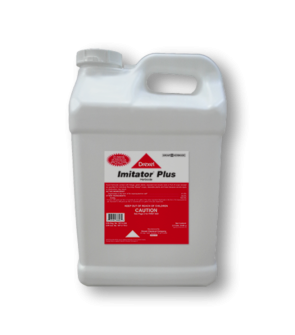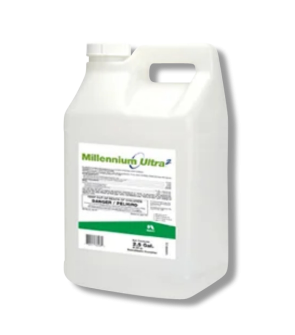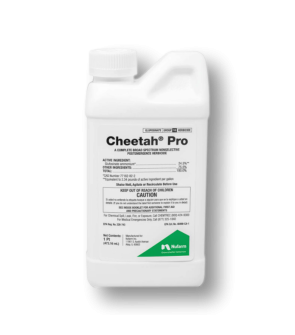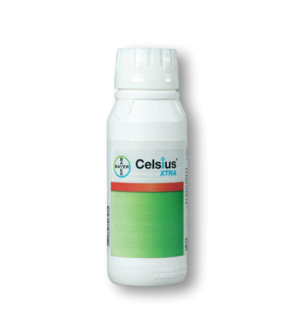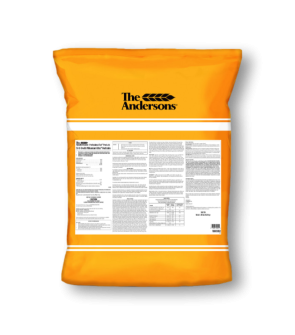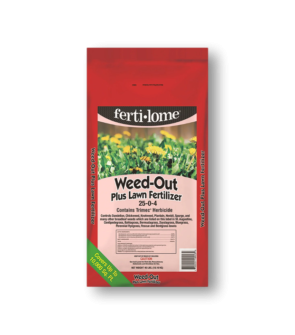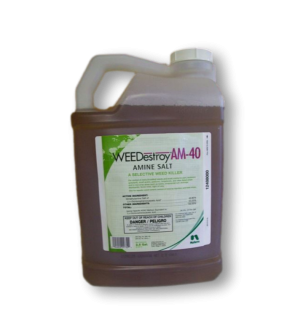Gain access to personalized product screening, the best pricing, rewards, and more!
Most Effective Products
Pokeweed Control: How To Get Rid of Pokeweed
This page is an expert guide on getting rid of pokeweed grass from your yard using the products and methods suggested by our experienced lawn care specialists. Follow this guide and use the recommended products, and we guarantee you will have a property free of pokeweed.
Pokeweed, also known as American pokeweed, poke sallet, pokeberry, dragonberries, pigeonberry weed, and inkberry is a tough weed that can appear in nurseries, home gardens, fields, and pastures. A shrub known to bear clusters of berries that resemble grapes, pokeweed is a toxic plant that is a hazard to livestock and can be a concern if you have curious pets and children who may pick the plant's fruit.
Pokeweed spreads by seed, which either falls off the plant or is picked up and moved around by birds. One pokeweed plant can produce 50,000 seeds during its lifespan, and the seeds can remain viable for nearly 40 years. This means pokeweed can create quite an infestation if no intervention controls its presence.
If your property is experiencing an outbreak of problematic pokeweed, our step-by-step DIY treatment guide will show you exactly how to get rid of it quickly and save money using our professional-grade herbicides.
Identification
Before proceeding with a control program for pokeweed, you must be sure it is the weed you are dealing with. Careless identification can lead to using the wrong treatment methods, costing you time and money. Here are some defining characteristics of what pokeweed looks like so you can correctly identify the weed:

- Pokeweed is a large shrub-like plant growing between 2 to 10 feet tall and 3 to 5 feet wide, developing thick, fleshy stems that turn bright pink to reddish purple by mid to late summer.
- The leaves are hairless, smooth, and fleshy, and the largest leaves can grow up to 20 inches long and 7 inches wide. The largest leaves grow towards the bottom of the plant and grow smaller towards the top. They grow in an alternating arrangement and are lance-shaped. The petioles are often reddish in color.
- Pokeweed grows multiple stems from a singular taproot. The stems are reddish in color, can grow up to 4 inches in diameter, and branch out towards the top.
- When pokeweed blooms, they grow white flowers in narrow, raceme-like flowerheads. These structures grow vertically, then droop as berries are formed. Berries start green, then become dark purple.
- Young plants have carrot-like roots, while older plants form thick, fleshy taproots that can reach 12 inches long and 4 inches thick or even 2 to 3 feet long in more mature plants.
Use the image and description above to identify pokeweed on your landscape properly. If you are unsure, contact us, and we will do our best to help you identify the correct one.
Inspection
After properly identifying that you are dealing with pokeweed, proceed with an inspection. During this phase, you will locate where pokeweed is growing on your property and observe the conditions allowing pokeweed to thrive.
Where to Inspect
Pokeweed can be found in most everyday places, especially in disturbed or partially shaded areas.
The most common places are pastures, clearings, woodland openings, in wastelands, along fences, fields, roadsides, ditches, forest edges, ornamental landscapes, parks, vacant lots, and areas where the soil has been recently tilled, farmed, or well-drained terrain.
What to Look For
When looking for pokeweed, watch out for a tall, bushy plant with thick, smooth stems that turn bright pink to reddish-purple as it matures. The leaves will have a strong unpleasent scent when crushed.
In late summer and fall, look for grape-like strings of dark purple to almost black berries on red or pinkish stalks. Earlier in the season, these clusters hold small green berries or white-green flowers.
During early to mid-summer, pokeweed produces strings of small, creamy-white flowers that later become berries.
Treatment
Always wear the proper personal protective equipment (PPE) when handling herbicides and since pokeweed is toxic to people.
Pokeweed grows rapidly in mid-to late summer, so spring is the best time to get control.
While several herbicides work well against pokeweed, our top recommendation for control is 2,4-D Amine Selective Post-Emergent Herbicide and Fahrenheit Herbicide because of it's selective and systemic means of control and ease of use.
Step 1: Measure and Mix Herbicide
Determine how much herbicide to use by measuring the square footage of the treatment area. Find the square footage by measuring the treatment area's length and width in feet, then multiplying them together (length X width = square footage).
Fahrenheit Herbicide is an effective post-emergent herbicide that eliminates broadleaf and grassy weeds in warm-seasoned turf.
For spot applications with Fahrenheit Herbicide, mix 0.2 oz. per one gallon of water per 1,000 sq. ft.
To enhance this product’s efficacy, mix in a surfactant like Nanotek. Nanotek is a non-herbicide product designed to improve the adhesion and penetration of pesticides onto treated surfaces. Add 1 fluid ounce of Nanotek per 1 gallon of solution you’ve made.
2,4-D Amine Selective Post-Emergent Herbicide is a reliable selective post-emergent herbicide concentrate that targets broadleaf weeds, brush, and vines in crops, pastures, rangelands, non-croplands, and more.
For spot treatments with 2,4-D Amine Selective Post-Emergent Herbicide, use 1/4 pint of this product in 3 gallons of water.
Applications with either of these herbicides will need to be done with a handheld pump sprayer or backpack sprayer.
Once you have made your measurements and calculated how much product you need, mix the product and surfactant together. Add half the amount of water, add the proper amount of herbicide, pour in the last half of water with the surfactant added in last.
Shake the sprayer to ensure the solution is well-mixed, and then you're ready to spray.
Step 2: Apply Herbicide To The Pokeweed
Use a sprayer with a fan nozzle setting to coat the pokeweed evenly with the herbicide.
Spray the weeds until they are wet, but just before the point of runoff.
Because pokeweed is so stubborn, you may need to make repeated applications until you no longer see any more pokeweed.
A repeat application may be required in 4 to 6 weeks with Fahrenheit Herbicide.
A second application can be done when 30 days have passed from the first treatment for 2,4-D Amine Selective Post-Emergent Herbicide.
Prevention
You must be cautious and watch for pokeweed to ensure it does not grow back. Here are some preventative measures to ensure pokeweed doesn't return.
- As soon as the pokeweed reemerges or sprouts, pulling them out with a glove covered hand from its roots would be best. Use a shovel to loosen the soil and pull out more remains of the pokeweed. Rake the pokeweed's remains and let them dry out under the sun.
- Persistence is extremely important for getting rid of the pokeweed. Pull out every flesh or ball of root from the soil. Dig up a circle around the plant that has been pulled out and then shuffle the soil to rake all the remains of the pokeweed. Lastly, dispose of them properly after it has been sundried.
- When used as part of prevention, Solutions 15-5-10 Weed & Feed can help by strengthening turf to outcompete weeds while controlling small early-growth broadleaf species, including young pokeweed. Solutions 15-5-10 Weed & Feed Fertilizer with Trimec is a slow-release granular fertilizer and post-emergent herbicide blend that controls emerged weeds while providing essential nutrients to turf. For most applications, you will need to apply 3.2 to 4 pounds of Solutions 15-5-10 Weed & Feed Fertilizer with Trimec per 1,000 square feet of treatment area. Mow lawn to normal height 1 to 2 days before application. Water lawn thoroughly at least 1 day before application to sustain moisture until the next watering. Spread the granules evenly across the treatment area. Do not wash from weed leaves for 1 to 2 days after application. At this time, a thorough watering should be made.
- Tillage can be an effective method for controlling true pokeweed seedlings if performed early. When done within 5 to 6 weeks after seedling emergence, regular cultivation or shallow tilling disrupts the young plants before they develop deep taproots, preventing them from establishing. At this stage, the seedlings are still fragile, and turning or disturbing the soil can destroy their roots and stop growth. However, once pokeweed matures and its taproot becomes large and fleshy, tillage alone will not eliminate the plant and may even stimulate regrowth from root fragments.
- After applying fertilizer, continue with integrated vegetation management to maintain your property’s health. Mow your grass at proper intervals to maintain a thick growing density, reduce the shade cast on your lawn by trimming overgrown shrubbery and tree branches, rake away leaf litter and pick up any debris, and employ a proper watering schedule to provide the local grass with enough water to strengthen its roots, but not so much that will encourage weeds. Many grasses require 1 inch of water every week. Apply the water all at once in the morning so it has time to seep into the ground without evaporating in the sun.
Key Takeaways
What is Pokeweed?
- Pokeweed is an herbaceous plant that invades landscapes and pastures. It is known for its toxicity and dark purple berries.
How to Get Rid of Pokeweed
- If pokeweed has appeared on your landscape, we recommend a post-emergent spot treatment with 2,4-D Amine Selective Post-Emergent Herbicide or Fahrenheit Herbicide.
Preventing Pokeweed Reinfestation
- We recommend pulling seedlings and taproots out by hand as soon as they emerge, and properly disposing of all plant remains for full pokeweed prevention. Tillage can help disrupt young pokeweeds. For turf areas, applying Solutions 15-5-10 Weed & Feed with Trimec helps eliminate young pokeweed, while strengthening grass to outcompete future growth.











